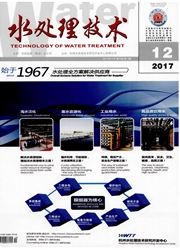

 中文摘要:
中文摘要:
试验采用SBR反应器处理模拟生活污水,考查溶氧DO与pH值对硝化过程中N2O释放量与硝化效率的影响。结果表明,在温度为28-30℃、反应器内MLSS约3500mg/L、水力停留时间为8.4h、污泥停留时间为25d时,pH值与DO水平对N2O的积累和硝化效率起着重要的作用。在pH值为9、DO为2mg/L时产生的N2O量最小,其最大释放浓度为3.59μgL/L,氨氮的转化效率为94.36%。在此条件下,既能减排N2O这种温室气体和减少能耗,又有很好的硝化效率,为污水厂生物脱氮过程中温室气体N2O的减排与构建清洁的废水处理工艺奠定了基础。
 英文摘要:
英文摘要:
A SBR was used for treatment of synthetic domestic wastewater. It was investigated the effect ofpH and DO on NO emission and nitrification efficiency during the nitrification process. The experimental results showed that pH .and DO concentration were the determining factors for NO accumulation and nitrification efficiency, when temperature, MLSS, HRT and SRT were 28-30℃, 3500mg/L, 8.5 h and 25 d respectively. When pH and DO concentration were 9 and 2 mg/L, there was a little NO emission and its peak concentration was 3.59μL/L. The convert ratio of NH4^+-N was 94.36%. Under this condition, it not only suppressed N2O emission and decreased energy consumption but also had high nitrification efficiency. This may become the foundation for N2O emission suppression of actual wastewater treatments.
 同期刊论文项目
同期刊论文项目
 同项目期刊论文
同项目期刊论文
 期刊信息
期刊信息
